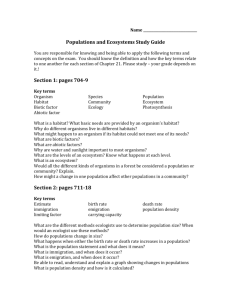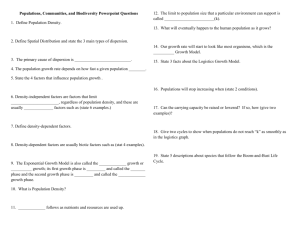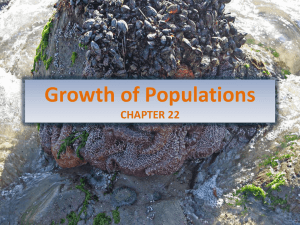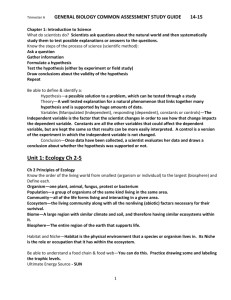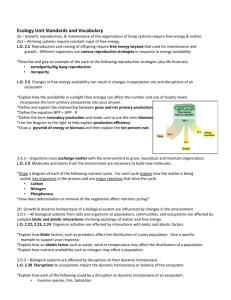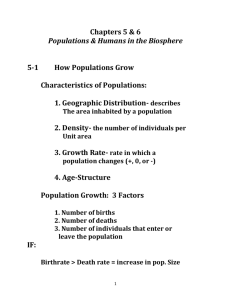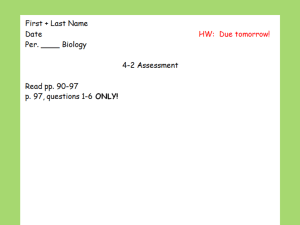Ecology EOC Review
advertisement
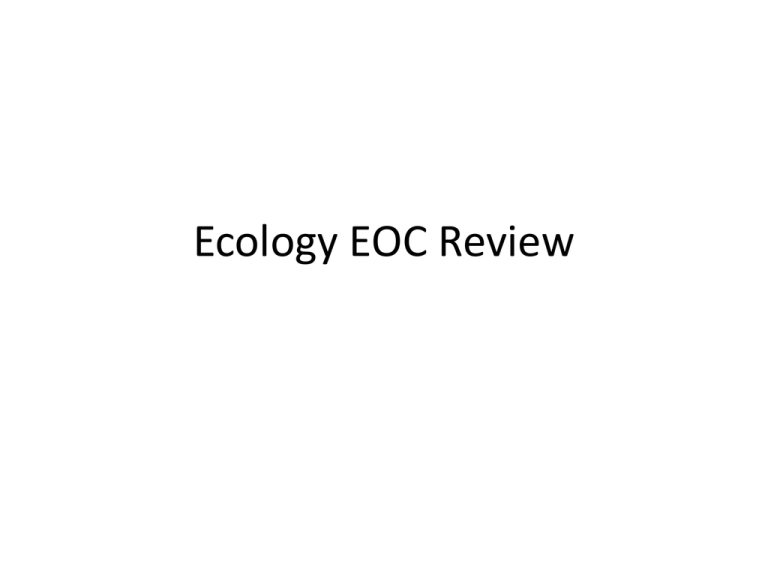
Ecology EOC Review Biotic vs. Abiotic Factors – Biotic = living (plants, animals, bacteria, fungus, protists) – Abiotic = non-living (temp, water, soil, weather, rocks, sunlight, etc) Ecological Organization – Organism ~ one member of one species – Population ~ all members of one species in a given area – Community ~ all populations in a given area – Ecosystem ~ all members of community plus abiotic factors in the area – Biome ~ group of ecosystems with same climate and organisms The Water Cycle The Carbon Cycle The Nitrogen Cycle Succession – Primary Succession = colonization of NEW land by pioneer species until a climax community is reached. • Lava flow lichens mosses grasses shrubs trees – Secondary Succession = existing community is destroyed and a new one begins to form • Occurs more quickly than primary succession because soil is already present and seeds were left behind • Forest Fire mosses grasses shrubs trees Ecosystem Relationships – Niche vs. Habitat • If an organism’s habitat is its address, its niche is its occupation. – Competition • Organisms of same or different species try to use same resource at same place during same time. • Competition can be reduced by developing different niches. • Ex. 3 species can easily live in same tree if one eats leaves, one eats bark and another eats the flowers. – Predator-Prey • Organism doing killing = predator • Organism being killed = prey Symbiosis • Mutualism – both species benefit from the relationship –Flowers may feed on insects, which may in turn disperse pollen to other flowers • Commensalism – one species benefits and the other is unaffected by the relationship –Barnacles attach to the skin of a whale to catch more food particles • Parasitism – one species benefits and the other is harmed by the relationship –Tapeworms live inside a human intestine and feed from the human Energy Flow – Producers (autotrophs) • Use sunlight to make their food and energy through photosynthesis or chemosynthesis • Only plants and some bacteria/algae are autotrophic – Consumers (heterotrophs) • • • • • • Must acquire their energy from other organisms Herbivores = eat plants only Carnivores = eat animals only Omnivores = eat both plants and animals Scavengers = eat dead or decaying plants and animals Decomposers = break down dead or decaying plants or animals Feeding Relationships • Food Chains = series of steps in which organisms transfer energy by eating and being eaten –Arrow shows the direction of energy transfer in the food chain –Ex. Grass Grasshopper Mouse Snake Hawk Feeding Relationships • Food web = links all food chains together in an ecosystem Trophic Levels –Producers – get energy from sun & use some for own metabolism –Primary Consumers – get 10% of original energy from producers and use some for own metabolism –Secondary Consumers – get 10% of energy from primary consumers and use some for own metabolism –Tertiary Consumers – get 10% of energy from secondary consumers and use some for own metabolism Ecological Pyramids Populations – Population Growth • If birth rate is larger than death rate = growing • If birth rate is smaller than death rate = shrinking • Immigration = movement into a population • Emigration = movement out of a population Populations – Exponential Growth (J-shaped Curve) • Occurs when individuals reproduce at a constant rate (ex. every individual has 2 kids) • Will occur under ideal conditions with unlimited resources Populations – Carrying Capacity (S-shaped Curve) • A population’s growth slows or stops following a period of exponential growth • Carrying capacity = largest number of individuals that a given environment can support Populations – Limiting Factors • A factor that causes a population’s growth to decrease • Competition, predation, disease, climate extremes, human disturbance – Density-dependent vs. Density-independent • Density-dependent = limit a population according to population size –Competition, predation • Density-independent = affects all populations the same, regardless of size –Natural disasters Human Environmental Impacts – Human population is growing exponentially with no slowing in sight because of technological advances in medicine. – Humans are clearing habitats of plants and animals to have more room for cities & suburbs as well as space to grow more food for the growing populations. Human Environmental Impacts • Ozone depletion –Ozone protects us from harmful UV radiation from the sun –Chlorofluorocarbons (CFCs) destroy the ozone layer –CFCs are banned, but their affects are lasting as the ozone layer slowly heals itself Human Environmental Impacts • Global Warming –Burning of fossil fuels adds excess carbon dioxide in the atmosphere –Carbon dioxide is an insulator and traps heat in the atmosphere causing the global temperature to slowly rise. –Higher global temperatures could have devastating effects such as melting of glaciers and changes in weather patterns. Human Environmental Impacts • Pesticide Use –DDT and other pesticides are dangerous because they can contaminate groundwater and other water sources. –Biological magnification – concentrations of a harmful substance increase in organisms at higher trophic levels in a food web or a food chain. »Ex. algae pick up toxin from water they live in – plankton eat much algae to survive – small fish eat the plankton – large fish eat the large fish there is much more DDT in the large fish than the plankton because it has concentrated up the food chain. Practice Questions 1. Which situation would result in the greatest increase in the human population? A. B. C. D. decreased birth rate and increased death rate increased infant mortality and decreased death rate decreased death rate and increased birth rate increased birth rate and increased infant mortality 2. In a forest ecosystem, which is an abiotic factor? A. B. C. D. the amount of rainfall the size of the deer the type of trees the number of birds 3. In the carbon cycle, atmospheric carbon dioxide is converted into organic material by which process? A. B. C. D. cellular respiration decomposition photosynthesis transpiration 4. Why do ecosystems rarely contain more than a few trophic levels? A. B. C. D. Energy transfer efficiency is high. Energy transfer efficiency is low. Energy amounts remain constant. Energy cannot flow through levels. Practice Questions 5. Recent climate data suggests a global warming trend. The most likely cause could be an increase in which gas? A. B. C. D. A community is studied and several interactions are observed and recorded. oxygen carbon dioxide nitrogen hydrogen sulfide 6. Silt and nutrients from eroding farmland flow into a lake. As a result, which will most likely increase first? A. B. C. D. 7. fish population shore vegetation algae growth dissolved oxygen Which type of interaction could illustrate the process of mutualism? A. B. C. D. interaction A interaction B interaction C interaction D

